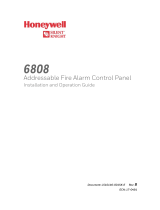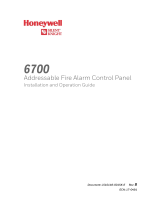Page is loading ...

D450-03-00 1 I56-0374-006R
B402B Plug-in Detector Base
For use with the following smoke detectors: 1451, 2451, and 2451TH
INSTALLATION AND MAINTENANCE INSTRUCTIONS
BEFORE INSTALLING
Please read the System Sensor manual I56-407, Guide for Proper Use of Sys-
tem Smoke Detectors, which provides detailed information on detector spacing,
placement, zoning, wiring, and special applications. Copies of this manual are
available at no charge from System Sensor. (For installations in Canada, refer
to CAN4-S524, Standard for the Installation of Fire Alarm Systems, and CEC
Part 1, Sec. 32.)
NOTICE: This manual should be left with the owner/user of this equipment.
IMPORTANT: The detector used with this base must be tested and maintained
regularly following NFPA 72 requirements. The detector used with this base
should be cleaned at least once a year.
GENERAL DESCRIPTION
The plug-in detector base B402B is used with System Sensor model 2451 and
2451TH photoelectronic detector heads, and model 1451 ionization detector
head. The capability of plugging these detectors into a variety of special bases
makes them more versatile than equivalent direct-wired models. Refer to the
System Sensor catalog for other available plug-in detector bases.
This B402B base is intended for use in 4-wire systems, with screw terminals
provided for power, remote annunciator, and relay contact connections. These
bases also contain a resistor to provide current limiting in the alarm state.
MOUNTING
This detector base mounts directly to 3
1
⁄
2
-inch and 4-inch octagon boxes, and
4-inch square boxes (with or without plaster). To mount the base, remove the
decorative ring by rotating it in either direction to unhook the snaps before
separating the ring from the base. Use the screws supplied with the junction
box to attach the base to the box through the appropriate slots in the base (see
Figure 1). Position the decorative ring around the base and rotate it in either
direction until the ring snaps into place.
SPECIFICATIONS
Base Diameter: 6.2 inches (15.7 cm)
Base Height: 1.1 inches (2.8 cm)
Weight: 0.3 lb. (130 g)
Mounting: 4 inch square box with or without plaster ring. Min. Depth: 1.5 inches
4 inch octagon box. Min. Depth: 1.5 inches
3-1/2 inch octagon box. Min. Depth: 1.5 inches
Operating Temperature Range: 0° to +49°C (32° to 120°F)
Operating Humidity Range: 10% to 93 % Relative Humidity, Non-condensing
Electrical Ratings — includes base and detector
System Voltage: 24 VDC
Maximum Ripple Voltage: 4 Volts peak to peak
Start-up Capacitance: 0.02 µF Maximum
Standby Ratings: 20 VDC Minimum
29 VDC Maximum
120 µA Maximum
Alarm Ratings: 17 mA Minimum
36 mA Maximum
Reset Voltage: 1.4 VDC Minimum
Reset Time: 0.3 Seconds Maximum
(If used, the RA400Z/RA100Z remote lamp operates within the specified
detector alarm currents.)
Start-up Time: 34.0 Seconds Maximum
Relay Contact Ratings
Resistive or Inductive (60% Power Factor):
Form A: 2.0A @ 30 VAC/DC
Form C: 2.0A @ 30 VAC/DC
0.6A @ 110 VDC
1.0A @ 125 VAC
INSTALLATION GUIDELINES
All wiring must be installed in compliance with the National Electrical Code,
all applicable local codes, and any special requirements of the authority hav-
ing jurisdiction, using the proper wire size. The conductors used to connect
smoke detectors to control panels and accessory devices should be color-coded
to reduce the likelihood of wiring errors. Improper connections can prevent a
system from responding properly in the event of a fire.
For signal wiring (the wiring between interconnected detectors), it is recom-
mended that the wire be no smaller than 18 gauge (1.0 square mm). The
screws and clamping plate in the base can accommodate wire sizes up to 12
gauge (2.5 square mm). For best system performance, the power (+ and –)
loop wire should be twisted pair and installed in separate grounded conduit to
minimize the effects of electrical interference.
Smoke detectors and alarm system control panels have specifications for al-
lowable loop resistance. Read the manual for the control to determine the
total loop resistance allowed before wiring the detector loops.
Locate installations where normal ambient temperature does not exceed
100°F.
WIRING INSTRUCTIONS (FIGURES 2 AND 3)
Wire connections are made by stripping approximately 3/8” (1 cm) insulation
from the end of each wire, sliding the bare end of the wire under the clamp
plate, and tightening the clamping plate screw. Use the strip gauges molded
into the inside and underside of the base for ease of wiring to terminals 1
through 5 and to terminals 12 through 14, respectively.
The zone wiring of the detector base should be checked before installing the
smoke detector head. To make this possible, this base contains a special-type
shorting jumper. After the detector base is wired and attached to the electrical
box, make sure that the shorting spring is in contact with the base of terminal
3. This temporary connection shorts the positive-in and positive-out leads and
permits the wiring of the loop to be checked for continuity.
I56-0374-006R
3825 Ohio Avenue, St. Charles, Illinois 60174
1.800.SENSOR2; Fax: 630.377.6495
www.systemsensor.com

D450-03-00 2 I56-0374-006R
Once all the detector bases have been wired and mounted, and the loop wir-
ing has been checked, the detector heads may be installed in the bases. The
shorting spring in the base will disengage automatically when the detector
head is removed from the base. DO NOT remove the shorting spring since it
reengages as the detector head is turned into the base, completing the circuit.
TAMPERPROOF FEATURE
CAUTION
Do not use the tamperproof feature if the XR5 removal tool is to be used.
This detector base can be made tamperproof to prevent the removal of the
detector head without the use of a tool. To activate this feature, break off the
tab on the detector base as shown in Figure 3A, then install the detector. To
remove the detector from the base once the tamperproof feature has been ac-
tivated, place a small-bladed screwdriver into the small hole on the side of the
base and push the plastic lever away from the detector head (see Figure 3B).
This will allow the detector to be rotated counterclockwise for removal.
NOTE: Head removal after the tamperproof feature has been activated first
requires removal of the decorative ring.
The tamperproof feature may be defeated by breaking and removing the plas-
tic lever from the base; however, this prevents ever using the feature again.
SNAP ON
DECORATIVE
RING
SCREWS
(NOT SUPPLIED)
DETECTOR
BASE
BOX
(NOT SUPPLIED)
SHORTING
SPRING
FIGURE 1. MOUNTING BASE TO BOX:
C0503-00

D450-03-00 3 I56-0374-006R
DETECTOR
POWER LOOP
(+)
(–)
ALARM
INITIATION LOOP
CONTROL PANEL
ALARM RELAY
AUXILIARY CONTACTS
N.O.
12
N.C.
13
C.
14
(2.8 VDC)
(+) (—)
1 4
ALARM
RELAY
REMOTE
ANNUNCIATOR
OUTPUT
(+IN) 2
3 (+OUT)
SHORTING
SPRING
5 (–IN, –OUT)
(IN)
10
(OUT)
11
ALARM RELAY
8
(IN)
9
(OUT)
FIRST DETECTOR IN LOOP
ALARM RELAY
AUXILIARY CONTACTS
N.O.
12
N.C.
13
C.
14
(2.8 VDC)
(+) (—)
1 4
ALARM
RELAY
REMOTE
ANNUNCIATOR
OUTPUT
(+IN) 2
3 (+OUT)
SHORTING
SPRING
5 (–IN, –OUT)
(IN)
10
(OUT)
11
ALARM RELAY
8
(IN)
9
(OUT)
FIRST DETECTOR IN LOOP
EOL
RESISTOR
EOL RELAY
(+)
(–)
NOTE: Schematic
Shown for
Reference
CAUTION
For system supervision–DO NOT use looped wire under terminals 2, 3, and 5.
Break wire run to provide supervision of system.
1
2
3
4
5
8
9
10
11
12
13
14
UL LISTED 4-WIRE CONTROL PANEL
REMOTE
ANNUNCIATOR
RELEASING
DEVICE
(OPTIONAL)
1
2
3
4
5
8
9
10
11
12
13
14
REMOTE
ANNUNCIATOR
POWER LOOP
+
POWER LOOP –
ALARM CIRCUIT
RELEASING
DEVICE
(OPTIONAL)
EOL RELAY
RESISTOR
+
–
+
–
+
–
EOL
FIGURE 3. TYPICAL WIRING DIAGRAM:
FIGURE 2.
NOTE: For wiring or releasing device, refer to manufacturer’s installation in-
structions.
C0532-01
C0533-00

D450-03-00 4 I56-0374-006R
©2009 System Sensor
System Sensor warrants its enclosed smoke detector base to be free from defects in ma-
terials and workmanship under normal use and service for a period of three years from
date of manufacture. System Sensor makes no other express warranty for this smoke
detector base. No agent, representative, dealer, or employee of the Company has the au-
thority to increase or alter the obligations or limitations of this Warranty. The Company’s
obligation of this Warranty shall be limited to the repair or replacement of any part of the
smoke detector base which is found to be defective in materials or workmanship under
normal use and service during the three year period commencing with the date of manu-
facture. After phoning System Sensor’s toll free number 800-SENSOR2 (736-7672) for a
Return Authorization number, send defective units postage prepaid to: System Sensor,
PLASTIC LEVER
BREAK TAB AT DOTTED LINE BY
TWISTING TOWARD CENTER OF BASE
USE SMALL-BLADED SCREWDRIVER TO PUSH
PLASTIC LEVER IN DIRECTION OF ARROW
FIGURE 3A. ACTIVATING TAMPERPROOF FEATURE: FIGURE 3B. REMOVING DETECTOR HEAD FROM BASE:
C0130-00
Please refer to insert for the Limitations of Fire Alarm Systems
THREE-YEAR LIMITED WARRANTY
Repair Department, RA #__________, 3825 Ohio Avenue, St. Charles, IL 60174. Please
include a note describing the malfunction and suspected cause of failure. The Company
shall not be obligated to repair or replace units which are found to be defective because
of damage, unreasonable use, modifications, or alterations occurring after the date of
manufacture. In no case shall the Company be liable for any consequential or incidental
damages for breach of this or any other Warranty, expressed or implied whatsoever, even
if the loss or damage is caused by the Company’s negligence or fault. Some states do not
allow the exclusion or limitation of incidental or consequential damages, so the above
limitation or exclusion may not apply to you. This Warranty gives you specific legal
rights, and you may also have other rights which vary from state to state.
/



